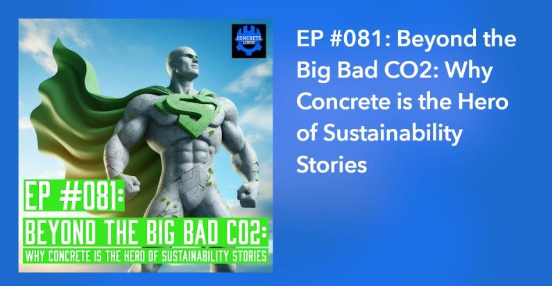A Concrete Logic Podcast episode with guest Aaron Fisher, PhD, Vice President of Business Development, Ernest Maier, Inc.
While definitions of sustainability vary, we can all agree that there is a responsibility to meet the needs of today without compromising the ability of future generations to meet their own needs. Aaron contends that while many stakeholders and decision makers are laser focused on embodied carbon or green house gas emissions, if you only look at the CO2 piece of the sustainability puzzle you often undermine your goals. Concrete accomplishes what owners are trying to achieve.
He discusses the importance of engaging with sustainability in the concrete industry and highlights the need for concrete professionals to be part of the conversation and influence the rules and regulations being developed.
Aaron explains how the focus on CO2 emissions has led to an oversimplification of sustainability and the need to consider other factors such as water usage, fire resistance, and durability. He emphasizes the importance of presenting a comprehensive case for concrete's sustainability and resilience, and the need to push back against misleading messaging and lobbying efforts.
What Sustainability Variables Should be Evaluated Beyond CO2?
Focusing on cradle to gate or only raw material extraction, transportation, and material production shortchanges a building’s entire life cycle by not including the most intensive use of a building’s function and operation; we should be having a cradle to grave discussion. Aaron creates a compelling comparison by using asbestos as an example. Asbestos was once a highly utilized building material – it was low cost, readily available, and fire resistive – up until we learned of its adverse effects on human health. Material selection should be based on much more than a few physical properties that we place value on. Certainly, concrete manufacturers can do better and they are. Removing cement from concrete mixes with other supplementary materials is happening and can reduce C02 by 10%.
He advocates for selecting materials more holistically. Thinking about the fire performance of the structure and what it costs to ensure the building. Mass timber requires gypsum and other materials to achieve fire resistance. Can you reduce the HVAC unit to make the building more energy efficient and lower CO2 over the life of the building? You can if building with concrete insulated wall panels. The insurance industry does place value on these properties and the lower risk of a total building loss from fire when building with concrete structural and building enclosure systems. A total rebuild if a timber building burns down would have a more significant impact to a carbon budget than a rehab if building with concrete. So we’re really talking about resilience and carbon efficiency.
Complete a Building Life-Cycle Assessment to get the Full Story
A life-cycle assessment, or LCA, is a standardized method for examining a broad range of environmental impacts associated with a process or a product over its complete life cycle. Only the LCA of a building can provide estimates of the full range of environmental burdens, such as embodied energy use and related fossil fuel depletion; other resource use; greenhouse gas emissions; and toxic release to air, water, and land.
When applied to buildings, an LCA includes:
- Resource extraction
- Manufacturing and transportation of materials and components
- On-site construction
- Building operations, including energy consumption and maintenance
- End-of-life, reuse, recycling, or disposal
In 2009, the Precast/Prestressed Concrete Institute (PCI) launched a comparative study to better understand prefabricated precast concrete system’s environmental life-cycle performance. The study’s primary objectives included:
- Foster a better understanding of the environmental impacts of precast/prestressed concrete components and their use in high-performance structures;
- Better understand precast concrete’s environmental life-cycle performance in mid-rise precast concrete buildings compared to alternative structural and envelope systems;
- Benchmark the industry’s performance in order to track its improvements; and
- Increase transparency in the marketplace.
The basis of comparison was a five-story, commercial, office building that meets minimum building and energy code requirements. The service life of the building was assumed to be 73 years. Precast concrete was compared to two other structural systems (steel and cast-in-place concrete), and two envelope systems (curtain wall and brick and steel studs). Precast concrete envelopes were also examined in three variations (solid wall, integral insulated wall, and integral insulated wall with embedded thin brick).
The findings from the study show that in almost all categories the differences are within the margins of error of the analysis. In other words, there is no significant difference in environmental impact between the systems over the full-service life of a building. This means that essentially material and system selection can be based on the benefits the materials and system provide, without an environmental tradeoff.
Want to read the full LCA white paper? Download the white paper here:
To listen to the full Concrete Logic podcast, click here:
About Ernest Maier, Inc.
Since 1926, Ernest Maier has been all about construction. Starting as Washington DC’s best and most trusted masonry block manufacturer. The Ernest Maier family has grown to provide an array of concrete and building solutions to Mid-Atlantic contractors, architects, engineers, designers, and homeowners. In 2020, Ernest Maier acquired Concrete Building Systems (CBS) of Delmar, DE; a PCI-certified producer of structural precast and prestressed elements since 1981.
Product Portfolio
From ready-mix concrete to steel the Ernest Maier family of companies goes well beyond their roots making concrete masonry blocks. They manufacture and/or distribute aggregates, bricks, drainage, hardscapes, insulation, lintels, natural stone, pavers, sand, stone, stormwater solutions, tools, and even precast/prestressed concrete.






